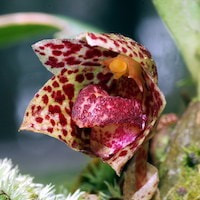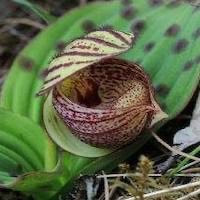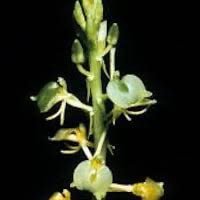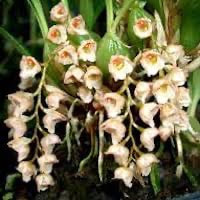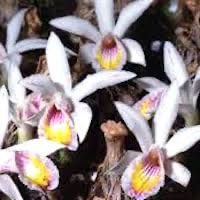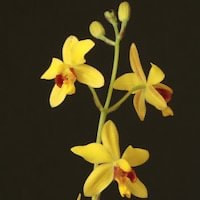MC5- Men's Citrus 5 - Go kiwi on this
|
Native Singaporean Orchid notes: Cymbidium Kanran
Cold Growing Cymbidiums, a type of orchid, are admired for their stunning beauty. Their large petals and distinct lip pattern attract attention. Originating from Indochina, Singapore, China, Taiwan, Japan, and the Ryukyu Islands, they emit a light, citrusy scent with sweet and musky notes that become stronger over time. Chinese herbalists value the plant for its ability to cleanse the heart, soothe the lungs, and treat coughs, asthma, gastroenteritis, and ascariasis, making it prized for both its beauty and medicinal benefits.
|
Therapeutic Orchid notes:
|
Bulbophyllum griffithi Syn. Bulbophyllum calodictyon Schltr., B. chitoense S.S. Ying, Sarcopodium griffithi Lindl
The Duanchishiduo Lan, also known as the stone bean orchid or small green stone bean orchid, thrives in various regions including central Taiwan, southeast Yunnan, Vietnam, northeast India, Bhutan, and Nepal. It blooms from February to November, depending on the location. In traditional medicine, it's valued for treating chronic coughs, bronchitis, and sore throats using fresh or dried pseudobulbs. These help ease lung issues, relieve pain, reduce inflammation, and heal fractures, abscesses, and sores, highlighting its medicinal versatility and aromatic allure in herbal practices. |
|
Cypripedium margaritaceum Franch.
The Banyeshao Lan, also known as Lanhuashuangyecao, thrives in deeply shaded environments with horizontally positioned leaves on the forest floor. In traditional Chinese medicine, it's prized for nourishing the liver and kidneys, balancing the body's vital energy (qi), and improving blood circulation. Valued for its diuretic properties, it reduces fluid retention and treats vision issues like blurred vision or night blindness. Boiling 9 to 15 grams of the herb extracts its beneficial compounds, making a medicinal decoction for liver and kidney support, diuresis, and vision enhancement. |
|
Liparis tschangii Schltr.
The Xizang Yangersuan, also known as Tibetan sheep ear garlic or Zhebao Yangersuan, thrives naturally in Tibet, southwest Sichuan, Yunnan, Laos, Thailand, and Vietnam, at elevations from 1100 to 1700 meters. In traditional Chinese medicine, its stems are prized for promoting blood circulation and treating issues like persistent vaginal bleeding. Harvested mainly in Tibet and Yunnan, these stems are processed into herbal remedies to aid clotting and manage excessive vaginal bleeding effectively. |
|
Pholidota yunnanensis Rolfe
The Shizaozi orchid species thrives in sparse woods, especially on karst formations and tree trunks, found in southeast Yunnan, southwest Guizhou, Guangxi, Hubei, Hunan in China, and parts of Vietnam, at elevations of 1200 to 1700 meters. It contains several beneficial compounds, including stilbenes and a bis(dihydrophenanthrene ether), known for their antioxidant properties and ability to inhibit nitric oxide production. Phoyunbene B, in particular, shows promise in inhibiting cancer cell growth. In traditional herbal medicine, the whole plant is used in pork porridge to treat coughs and asthma, while a rice spirit tincture is recommended for internal injuries, reflecting its medicinal significance. |
|
Pleione maculata (Lindl.) Lindl. & Paxton
The Qiuhuadusuan Lan, or autumn flowering single bulb orchid, grows as an epiphyte on tree trunks in broad-leaved, evergreen forests. It thrives in regions like western Yunnan in China, Bhutan, Sikkim, Arunachal Pradesh, Assam in India, Myanmar, and northern Thailand. In traditional herbal medicine, its pseudobulbs are used to treat liver issues and stomach aches in India and Nepal, varying in preparation methods and application. |
|
Spathoglottis pubescens Lindl.
The Chinese herb, known by various names including Baoshe Lan and Huanghuadusuan, originates from the region south of the Yangzi River. It's notable for colonizing Krakatoa after a volcanic eruption in 1883, showcasing its resilience. Despite thriving in harsh conditions, it's susceptible to viral infections and is used as an indicator plant for virus presence. Traditionally, its stem treats lung issues, relieves coughs, aids tissue healing, and forms poultices for external ailments. |
Other scent note
Scentopia Library Reference ingredient
Neroli - Check details at Scentopia's scent library
Download the guided mediation that works best with this Orchid fragrance oil
| men_citrus_essential_oil_orchi_00005.mp3 | |
| File Size: | 184820 kb |
| File Type: | mp3 |

